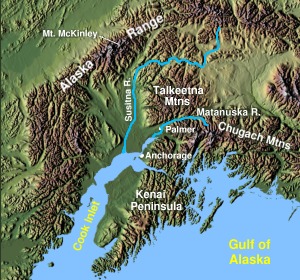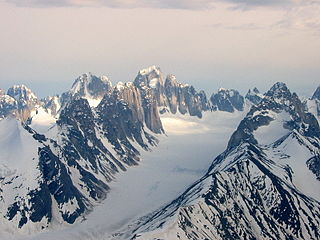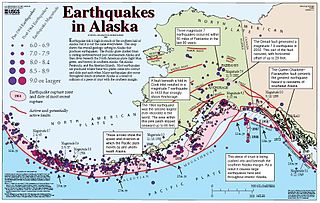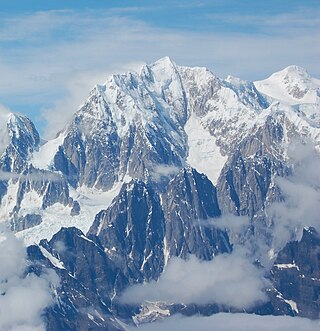
Matanuska-Susitna Borough is a borough located in the U.S. state of Alaska. Its borough seat is Palmer, and the largest community is the census-designated place of Knik-Fairview. As of the 2020 census, the borough's population was 107,801.

Talkeetna is a census-designated place (CDP) in Matanuska-Susitna Borough, Alaska, United States. At the 2020 census the population was 1,055, up from 876 in 2010.

Denali is the highest mountain peak in North America, with a summit elevation of 20,310 feet (6,190 m) above sea level. It is the tallest mountain in the world from base-to-peak on land, measuring 18,000 ft (5,500 m), With a topographic prominence of 20,194 feet (6,155 m) and a topographic isolation of 4,621.1 miles (7,436.9 km), Denali is the third most prominent and third-most isolated peak on Earth, after Mount Everest and Aconcagua. Located in the Alaska Range in the interior of the U.S. state of Alaska, Denali is the centerpiece of Denali National Park and Preserve.

The Alaska Range is a relatively narrow, 600-mile-long (950 km) mountain range in the southcentral region of the U.S. state of Alaska, from Lake Clark at its southwest end to the White River in Canada's Yukon Territory in the southeast. Denali, the highest mountain in North America, is in the Alaska Range. The range is part of the American Cordillera.

Denali National Park and Preserve, formerly known as Mount McKinley National Park, is a United States national park and preserve located in Interior Alaska, centered on Denali, the highest mountain in North America. The park and contiguous preserve encompass 6,045,153 acres which is larger than the state of New Hampshire. On December 2, 1980, 2,146,580-acre Denali Wilderness was established within the park. Denali's landscape is a mix of forest at the lowest elevations, including deciduous taiga, with tundra at middle elevations, and glaciers, snow, and bare rock at the highest elevations. The longest glacier is the Kahiltna Glacier. Wintertime activities include dog sledding, cross-country skiing, and snowmobiling. The park received 594,660 recreational visitors in 2018.

The Susitna River is a 313-mile (504 km) long river in the Southcentral Alaska. It is the 15th largest river in the United States, ranked by average discharge volume at its mouth. The river stretches from the Susitna Glacier to Cook Inlet's Knik Arm.

The Alaska Railroad is a Class II railroad that operates freight and passenger trains in the state of Alaska. The railroad's mainline runs between Seward on the southern coast and Fairbanks, near the center of the state. It passes through Anchorage and Denali National Park, to which 17% of visitors travel by train.

Denali State Park is a 325,240-acre (131,620 ha) state park in the U.S. state of Alaska. It is located in the Matanuska-Susitna Borough adjacent to the east side of Denali National Park and Preserve, along the Parks Highway.

Denali Highway is a lightly traveled, mostly gravel highway in the U.S. state of Alaska. It leads from Paxson on the Richardson Highway to Cantwell on the Parks Highway. Opened in 1957, it was the first road access to Denali National Park. Since 1971, primary park access has been via the Parks Highway, which incorporated a section of the Denali Highway from Cantwell to the present-day park entrance. The Denali Highway is 135 miles (217 km) in length.

The Kichatna Mountains are a small mountain range in the northwestern part of Matanuska-Susitna Borough of the U.S. state of Alaska, approximately 70 miles (110 km) southwest of Denali. Unlike the major snow peaks of much of the rest of the Alaska Range, the Kichatnas boast short, steep rock towers, which are famous both for their high-quality, highly technical climbing, and their terrible weather.

The 2002 Denali earthquake occurred at 22:12:41 UTC November 3 with an epicenter 66 km ESE of Denali National Park, Alaska, United States. This 7.9 Mw earthquake was the largest recorded in the United States in 37 years. The shock was the strongest ever recorded in the interior of Alaska. Due to the remote location, there were no fatalities and only one injury.

Isabel Pass is a 40 mile long gap in the eastern section of the Alaska Range which serves as a corridor for the Richardson Highway about 11 miles from Paxson. It is named after Isabelle Barnette, the wife of E. T. Barnette, who helped found Fairbanks. The pass separates four regions, the Tanana Valley to the north, the Delta Mountains to the east, Copper River Basin to the south, and the Hayes Range to the west.

Talkeetna Air Taxi, established in 1947 as Talkeetna Air Service, is a Talkeetna, Alaska-based flight company. It operates wheel-ski equipped bush planes, and is one of less than a half-dozen air services with a permit to land in Denali National Park. Historically, business included supply runs to remote homesteads and prospecting claims—though in the past decade traffic has been primarily tourist and climber related.

The Denali Fault is a major intracontinental dextral strike-slip fault in western North America, extending from northwestern British Columbia, Canada to the central region of the U.S. state of Alaska.
The Tintina Fault is a large right-lateral strike-slip fault in western North America, extending from Flathead Lake, Montana to the centre of the U.S. state of Alaska. It represents the Yukon continuum between the Rocky Mountain Trench in the northern United States and the Kaltag Fault in Alaska.

Mount Stevens is a mountain located in Matanuska-Susitna Borough, Alaska. Mount Stevens is flanked to the northwest by Mount Hunter, and is about 10 miles (16 km) south of Mount McKinley (Denali).

Matanuska-Susitna Valley is an area in Southcentral Alaska south of the Alaska Range about 35 miles (56 km) north of Anchorage, Alaska. It is known for the world record sized cabbages and other vegetables displayed annually in Palmer at the Alaska State Fair. It includes the valleys of the Matanuska, Knik, and Susitna Rivers. 11,000 of Mat-Su Valley residents commute to Anchorage for work . It is the fastest growing region in Alaska and includes the towns of Palmer, Wasilla, Big Lake, Houston, Willow, Sutton, and Talkeetna. The Matanuska-Susitna Valley is primarily the land of the Dena'ina and Ahtna Athabaskan people.

Traleika Glacier is a glacier in Denali National Park and Preserve in the U.S. state of Alaska. The glacier originates from two forks on either side of Farthing Horn on the east side of Denali. The west fork of the glacier starts in the Thayer Basin to the south of Denali, moving northeast and falling from the basin's 15,000-foot (4,600 m) height via the Traleika Icefall into the west fork between Karsten Ridge and the Farthing Horn. The main fork starts from Denali's east buttress in Traleika Col, joining the West Fork between the Farthing Horn and Mount Silverthrone, then moving northeast to join Muldrow Glacier. Traleika Glacier was named in 1945 by Bradford Washburn, attributing the name to a Susitna name meaning "great one" or "high one.". The form Traleika is an Anglicization of the Dena'ina name Dghelaay Ka'a, denoting Denali.
There are three glaciers named West Fork Glacier in Alaska, two of which are in the Alaska Range. The first West Fork Glacier is a glacier in Denali National Park and Preserve in the U.S. state of Alaska. The glacier originates at Anderson Pass, extending to the east and forming the source of the West Fork of the Chulitna River. Traleika Glacier was named in 1945 by Bradford Washburn, attributing the name to a Susitna name meaning "great one" or "high one." GNIS ID 1411870
The Totschunda Fault is a major active dextral (right-lateral) continental strike-slip fault in southeastern Alaska. It forms a link between the Denali Fault to the northwest and the Fairweather Fault to the southeast. The northwestern end of the fault ruptured during the 2002 Denali earthquake.




















